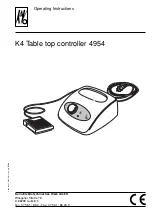
AMBE-2000™ Vocoder Chip Users Manual
Version 4.92, June, 08
DVSI Confidential Proprietary, Subject to Change
Page 35
Visit us at
www.dvsinc.com
Encoder Silence Detect: The Encoder Silence Detected Flag will be set to 1 when no voice activity is detected. The
Silence Detect option is controlled by and can be disabled by the VAD as described in section 5.2.9.
5.3.4
Framed Output: Words 2-6 : Rate Information
Rate Info 0, Rate Info 1, Rate Info 2, Rate Info 3, Rate Info 4.
Words 2-6 in the packet indicate the rate at which the AMBE-2020™ encoder is operating . These words are output. See
tables 5-C and 5-D for corresponding values.
5.3.5
Framed Output: Word 7 : Bit Error Rate
This status field is used for the decoder to report bit error information. The 16 bit number output is used to compute the
BER using the following calculation
% BER = (Word 7) / (32768) x 100
This status field works in conjunction with the RIS bits in control word 2. Every time the RIS bits are set to any value other
than 0x3, this field is reset. The BER is calculated only when using FEC provided by the AMBE-2020
™.
5.3.6
Framed Output: Word 8 : Soft Decision Distance
This status field is used in conjunction with hardware pin 79 SOFT_EN. This field is used to report the soft decision
distance for the most recent frame.
This status field works in conjunction with the RIS bits in control word 2. Every time the RIS bits are set to any value other
than 0x3, this field is reset. The Soft decision Distance is calculated only when using Soft Decision decoding provided by
the AMBE-2020
™.
5.3.7
Framed Output: Word 9 : Detected Bit Errors
This status field is used to report the number of detected bit errors in the current frame.
This status field works in conjunction with the RIS bits in control word 2. Every time the RIS bits are set to any value other
than 0x3, this field is reset. The number of bit errors is calculated only when using FEC provided by the AMBE-2020
™.
5.3.8
Framed Output: Word 10 : DTMF Control
This word corresponds to the DTMF Detection capabilities of the vocoder. It uniquely identifies specific tones recognized
by the encoder. See table 5-M for a list of tones and their corresponding values.
















































